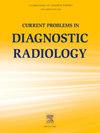初步调查:虚拟现实乳房活检模拟的可行性研究。
IF 1.5
Q3 RADIOLOGY, NUCLEAR MEDICINE & MEDICAL IMAGING
引用次数: 0
摘要
理由和目标:超声引导下的乳腺活检是最常见的影像引导乳腺手术。在培训过程中,学员可能会因为容量有限和解剖结构敏感而缺乏接触机会。目前的模拟培训通常使用人造或自制(鸡胸或火鸡胸)模型。虚拟现实技术是一种新兴技术,可让学员灵活学习,获得真实的互动体验和可衡量的反馈。本研究旨在评估新型虚拟现实乳房活检模拟培训器的可行性:这是一项符合 HIPAA 标准、经 IRB 批准的前瞻性可行性研究。参与者是三位接受过研究培训的乳腺放射科医生,他们的工作年限各不相同。参与者接受了虚拟现实(VR)乳腺活检模拟介绍和简短的培训课程,介绍了如何进入模拟和浏览控件。参与者被要求在 15 分钟内尽可能多地进行乳腺活检。一个活检周期包括用活检针进入乳房、采集活检样本和拔出活检针。VR 程序记录了成功活检肿块的时间,记录这些数据是为了评估从模拟开始到结束的改进情况。模拟完成后,所有参与者都立即进行了术后调查。此外,还通过 Qualtrics 获得了定性的开放式主观反馈:所有三位乳腺放射科医生都完成了模拟操作。结果:三位乳腺放射科医生都完成了模拟操作,操作过程中没有出现任何并发症,也没有因晕动病或疲劳而终止模拟操作。从模拟中获得的数据结果显示,所有三位乳腺放射科医生的成功活检时间(斜率=-19.23)随着每次试验的进行而缩短。活检时间的缩短与成功活检的累计次数增加有关(p = 0.0037)。累计成功活检次数的增加与成功采集组织样本前身体进入次数(p = 0.0332)和活检火力(p = 0.0221)的减少有关。李克特量表调查结果的平均值总体较高。放射科医生认为模拟器引人入胜(4.67/5.00 ± 0.47)、逼真(2.67/3.00 ± 0.47),并愿意向其他医护人员推荐该模拟器(2.67/3.00 ± 0.47)。参与试验的放射科医生也提供了总体良好的主观反馈:本研究提出了一种利用 VR 模拟进行超声引导下乳腺活检培训的新方法,该方法成功地记录了每次活检尝试的完成时间。未来的研究将致力于评估该模拟在提高受训者技能方面的实用性。本文章由计算机程序翻译,如有差异,请以英文原文为准。
Preliminary investigation: Feasibility study of a virtual reality breast biopsy simulation
Rationale and Objectives
Ultrasound-guided breast biopsies are the most frequently performed imaging-guided breast procedures. During training, learners may lack exposure due to limited volume and sensitive anatomy. Current simulation training often involves the use of manufactured or homemade (chicken or turkey breast) phantoms. Virtual reality is an emerging technology, allowing learners to have flexibility in learning, real-life interactive experiences and measurable feedback. The purpose of this study is to assess the feasibility of a novel virtual reality breast biopsy simulation trainer.
Methods
This was a HIPAA-compliant, IRB-approved prospective feasibility study. The participants were three fellowship-trained breast radiologists with varying years of experience. Participants received an introduction to the virtual reality (VR) breast biopsy simulation and brief training session, describing how to enter the simulation and navigate controls. The participants were instructed to perform as many breast biopsies as possible within a 15-min time period. One biopsy cycle consisted of entering the breast with the biopsy needle, taking a biopsy sample and removing the needle. Time to successfully biopsy the mass was recorded by the VR program, and this data was recorded to assess improvement from start to finish of the simulation. A post-procedure survey was administered to all participants immediately after completion of the simulation. Qualitative open-ended subjective feedback was also obtained via Qualtrics.
Results
All three breast radiologists completed the simulation. There were no complications from the procedure, including no motion sickness or fatigue resulting in simulation termination. Results of data obtained from the simulation showed decreased time to successful biopsy (slope = -19.23) with each subsequent trial for all three participant breast radiologists. A decreased time to biopsy was associated with a higher cumulative number of successful biopsies (p = 0.0037). A higher number of cumulative successful biopsies was associated with decreased number of body entries (p = 0.0332) and biopsy fires (p = 0.0221) before a successful tissue sample. Mean responses for Likert scale survey results were overall high. The radiologists found the simulator to be engaging (4.67/5.00 ± 0.47), realistic (2.67/3.00 ± 0.47) and would recommend the simulation to other healthcare professionals (2.67/3.00 ± 0.47). The radiologists participating in the trial also provided overall favorable subjective feedback.
Conclusions
This study presents a novel approach for ultrasound-guided breast biopsy training with a VR simulation that showed to be successfully capable of recording time-to-completion of each biopsy attempt. Future studies will be directed toward assessing the utility of the simulation in improving trainee skills.
求助全文
通过发布文献求助,成功后即可免费获取论文全文。
去求助
来源期刊

Current Problems in Diagnostic Radiology
RADIOLOGY, NUCLEAR MEDICINE & MEDICAL IMAGING-
CiteScore
3.00
自引率
0.00%
发文量
113
审稿时长
46 days
期刊介绍:
Current Problems in Diagnostic Radiology covers important and controversial topics in radiology. Each issue presents important viewpoints from leading radiologists. High-quality reproductions of radiographs, CT scans, MR images, and sonograms clearly depict what is being described in each article. Also included are valuable updates relevant to other areas of practice, such as medical-legal issues or archiving systems. With new multi-topic format and image-intensive style, Current Problems in Diagnostic Radiology offers an outstanding, time-saving investigation into current topics most relevant to radiologists.
 求助内容:
求助内容: 应助结果提醒方式:
应助结果提醒方式:


